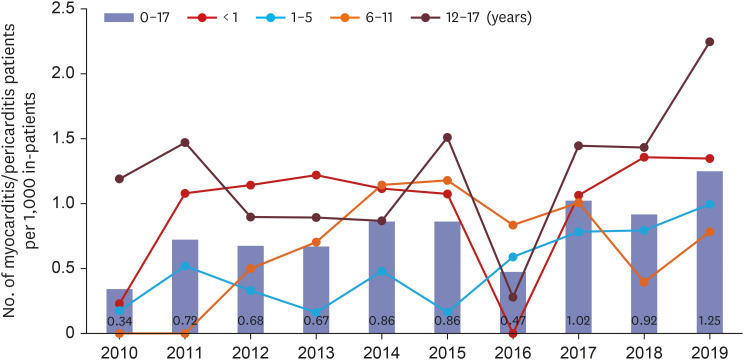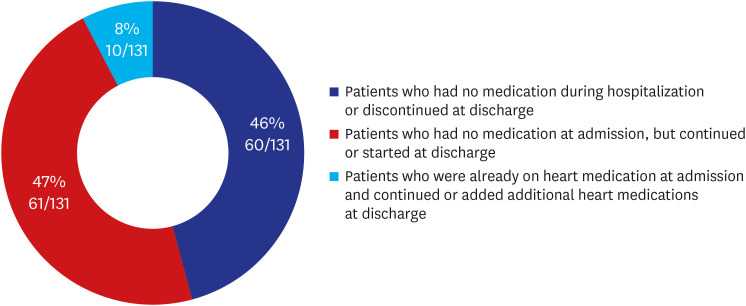J Korean Med Sci.
2021 Aug;36(32):e232. 10.3346/jkms.2021.36.e232.
Epidemiology and Clinical Features of Myocarditis/Pericarditis before the Introduction of mRNA COVID-19 Vaccine in Korean Children: a Multicenter Study
- Affiliations
-
- 1Department of Pediatrics, Samsung Medical Center, Sungkyunkwan University School of Medicine, Seoul, Korea
- 2Department of Pediatrics, Seoul National University Children's Hospital, Seoul National University College of Medicine, Seoul, Korea
- KMID: 2519228
- DOI: http://doi.org/10.3346/jkms.2021.36.e232
Abstract
- Background
Korean health authority plans to vaccinate adolescents against coronavirus disease 2019 (COVID-19) starting high school seniors during the summer vacation of 2021. However, the myocarditis/pericarditis following COVID-19 vaccine has been reported recently in adolescents and young adults. This study was performed to answer the urgent questions about the basic epidemiology and clinical course of myocarditis/pericarditis in hospitalized patients prior to the introduction of COVID-19 vaccines in pediatric population.
Methods
A retrospective medical record analysis including frequency, clinical characteristics, etiology and outcome of myocarditis/pericarditis was conducted in 17 years and younger patients who were hospitalized in two referral hospitals in Korea between 2010 and 2019.
Results
Total 142 patients with myocarditis (n = 119) and/or pericarditis (n = 23) were identified. Median age was 5.4 years (interquartile range, 0.6–12.9 years; range, 11 days–17.8 years), and male was 61%. In adolescents aged 12–17 years, the male to female ratio was 3.2. Myocarditis/pericarditis occurred 0.70 per 1,000 in-patients during the study period: 0.96 (< 1 year), 0.50 (1–5 years), 0.67 (6–11 years) and 1.22 (12–17 years) per 1,000 in-patients, respectively. There was an increasing tendency for the annual frequency from 0.34 in 2010 to 1.25 per 1,000 in-patients in 2019 (P = 0.021). Among the 56 (40%) proven pathogens at admission, Mycoplasma pneumoniae (n = 11, 8%) and enterovirus (n = 10, 7%) were most common. Of the 142 patients, 99 (70%) required pediatric intensive care unit care and 10 (7%) received heart transplantation. In addition, 61 patients (61/131, 47%) without heart medication at admission needed heart medication when they were discharged. Eleven (7.7%) patients died, of which five patients were previously healthy. The median age of deceased patients was lower than the survival group (0.8 vs. 6.3 years, P = 0.014).
Conclusion
The frequency of myocarditis/pericarditis was highest among male adolescent in-patients; however, the outcome was favorable in this group without any mortality.
Keyword
Figure
Cited by 1 articles
-
Clinical Features of Patients Presenting to the Emergency Department With Cardiovascular Adverse Reactions After COVID-19 mRNA Vaccination
Tae Hoon Oh, Seon Hee Woo, Sungyoup Hong, Carol Lee, Woon Jeong Lee, Si Kyoung Jeong
J Korean Med Sci. 2022;37(9):e73. doi: 10.3346/jkms.2022.37.e73.
Reference
-
1. Pollack A, Kontorovich AR, Fuster V, Dec GW. Viral myocarditis--diagnosis, treatment options, and current controversies. Nat Rev Cardiol. 2015; 12(11):670–680. PMID: 26194549.
Article2. Fung G, Luo H, Qiu Y, Yang D, McManus B. Myocarditis. Circ Res. 2016; 118(3):496–514. PMID: 26846643.
Article3. Basso C, Leone O, Rizzo S, De Gaspari M, van der Wal AC, Aubry MC, et al. Pathological features of COVID-19-associated myocardial injury: a multicentre cardiovascular pathology study. Eur Heart J. 2020; 41(39):3827–3835. PMID: 32968776.
Article4. World Health Organization. WHO coronavirus (COVID-19) dashboard. Updated 2021. Accessed July 1, 2021. https://covid19.who.int/.5. Kang HM, Choi EH, Kim YJ. Updates on the coronavirus disease 2019 vaccine and consideration in children. Clin Exp Pediatr. 2021; 64(7):328–338. PMID: 34148333.
Article6. Korean Disease Control and Prevention Agency. Weekly COVID-19 vaccination adverse event (Week 17). Updated 2021. Accessed July 2, 2021. https://ncv.kdca.go.kr/board.es?mid=a11707010000&bid=0032#content.7. Centers for Disease Control and Prevention, COVID data tracker. Updated 2021. Accessed July 6 2021. https://covid.cdc.gov/covid-data-tracker/#vaccinations-cases-trends.8. Centers for Disease Control and Prevention. Advisory committee on immunization practices (ACIP), COVID-19 vaccine safety updates, June 23, 2021. Updated 2021. Accessed July 6, 2021. http://cdc.gov/coronavirus.9. Korean Disease Control and Prevention Agency. Press release, July 1 2021. Updated 2021. Accessed July 2, 2021. http://ncov.mohw.go.kr/tcmBoardView.do?brdId=3&brdGubun=31&dataGubun=&ncvContSeq=5626&contSeq=5626&board_id=312&gubun=ALL.10. Caforio AL, Pankuweit S, Arbustini E, Basso C, Gimeno-Blanes J, Felix SB, et al. Current state of knowledge on aetiology, diagnosis, management, and therapy of myocarditis: a position statement of the European Society of Cardiology Working Group on Myocardial and Pericardial Diseases. Eur Heart J. 2013; 34(33):2636–2648. PMID: 23824828.
Article11. Adler Y, Charron P, Imazio M, Badano L, Barón-Esquivias G, Bogaert J, et al. The 2015 ESC guidelines on the diagnosis and management of pericardial diseases. Eur Heart J. 2015; 36(42):2873–2874. PMID: 26547486.12. Kim NH, Lee JA, Eun BW, Shin SH, Chung EH, Park KW, et al. Comparison of polymerase chain reaction and the indirect particle agglutination antibody test for the diagnosis of Mycoplasma pneumoniae pneumonia in children during two outbreaks. Pediatr Infect Dis J. 2007; 26(10):897–903. PMID: 17901794.13. Greinacher A, Thiele T, Warkentin TE, Weisser K, Kyrle PA, Eichinger S. Thrombotic thrombocytopenia after ChAdOx1 nCov-19 vaccination. N Engl J Med. 2021; 384(22):2092–2101. PMID: 33835769.
Article14. Korean Disease Control and Prevention Agency. Press release, April 11, 2021. Updated 2021. Accessed July 2, 2021. http://ncov.mohw.go.kr/tcmBoardView.do?brdId=3&brdGubun=31&dataGubun=&ncvContSeq=5156&contSeq=5156&board_id=312&gubun=BDJ.15. Medicines and Healthcare products Regulatory Agency (UK). Press release, April 7, 2021. Updated 2021. Accessed July 2, 2021. https://www.gov.uk/government/news/mhra-issues-new-advice-concluding-a-possible-link-between-covid-19-vaccine-astrazeneca-and-extremely-rare-unlikely-to-occur-blood-clots.16. European Medicines Agency. AstraZeneca's COVID-19 vaccine: EMA finds possible link to very rare cases of unusual blood clots with low blood platelets, April 7, 2021. Updated 2021. Accessed July 2, 2021. https://www.ema.europa.eu/en/news/astrazenecas-covid-19-vaccine-ema-finds-possible-link-very-rare-cases-unusual-blood-clots-low-blood.17. Marshall M, Ferguson ID, Lewis P, Jaggi P, Gagliardo C, Collins JS, et al. Symptomatic acute myocarditis in seven adolescents following Pfizer-BioNTech COVID-19 vaccination. Pediatrics. Forthcoming. 2021; DOI: 10.1542/peds.2021-052478.18. Belay ED, Abrams J, Oster ME, Giovanni J, Pierce T, Meng L, et al. Trends in geographic and temporal distribution of US children with multisystem inflammatory syndrome during the COVID-19 pandemic. JAMA Pediatr. 2021; 175(8):837–845. PMID: 33821923.
Article19. Choe YJ, Choi EH, Choi JW, Eun BW, Eun LY, Kim YJ, et al. Surveillance of COVID-19-associated multisystem inflammatory syndrome in children, South Korea. Emerg Infect Dis. 2021; 27(4):1196–1200. PMID: 33539720.
Article20. Koean Statistical Information Service. 2019 Population census updated by the KOSIS. Updated 2021. Accessed July 7, 2021. https://kosis.kr/statisticsList/statisticsListIndex.do?vwcd=MT_ZTITLE&menuId=M_01_01#content-group.21. Halsell JS, Riddle JR, Atwood JE, Gardner P, Shope R, Poland GA, et al. Myopericarditis following smallpox vaccination among vaccinia-naive US military personnel. JAMA. 2003; 289(24):3283–3289. PMID: 12824210.
Article22. Kumar V, Sidhu N, Roy S, Gaurav K. Myocarditis following diphtheria, whole-cell pertussis, and tetanus toxoid vaccination in a young infant. Ann Pediatr Cardiol. 2018; 11(2):224–226. PMID: 29922028.
Article23. Kim J, Cho MJ. Acute myocarditis in children: a 10-year nationwide study (2007–2016) based on the Health Insurance Review and Assessment Service Database in Korea. Korean Circ J. 2020; 50(11):1013–1022. PMID: 32812406.
Article24. Arola A, Pikkarainen E, Sipilä JO, Pykäri J, Rautava P, Kytö V. Occurrence and features of childhood myocarditis: a nationwide study in Finland. J Am Heart Assoc. 2017; 6(11):e005306. PMID: 29151030.
Article
- Full Text Links
- Actions
-
Cited
- CITED
-
- Close
- Share
- Similar articles
-
- A Case of Myocarditis Presenting With a Hyperechoic Nodule After the First Dose of COVID-19 mRNA Vaccine
- COVID-19 vaccination–related cardiovascular complications
- The incidence and clinical characteristics of myocarditis and pericarditis following mRNA-based COVID-19 vaccination in Republic of Korea adolescents from July 2021 to September 2022
- Cardiac Magnetic Resonance Imaging Findings and Clinical Features of COVID-19 Vaccine-Associated Myocarditis, Compared With Those of Other Types of Myocarditis
- Acute myocarditis associated with anti-COVID-19 vaccination



